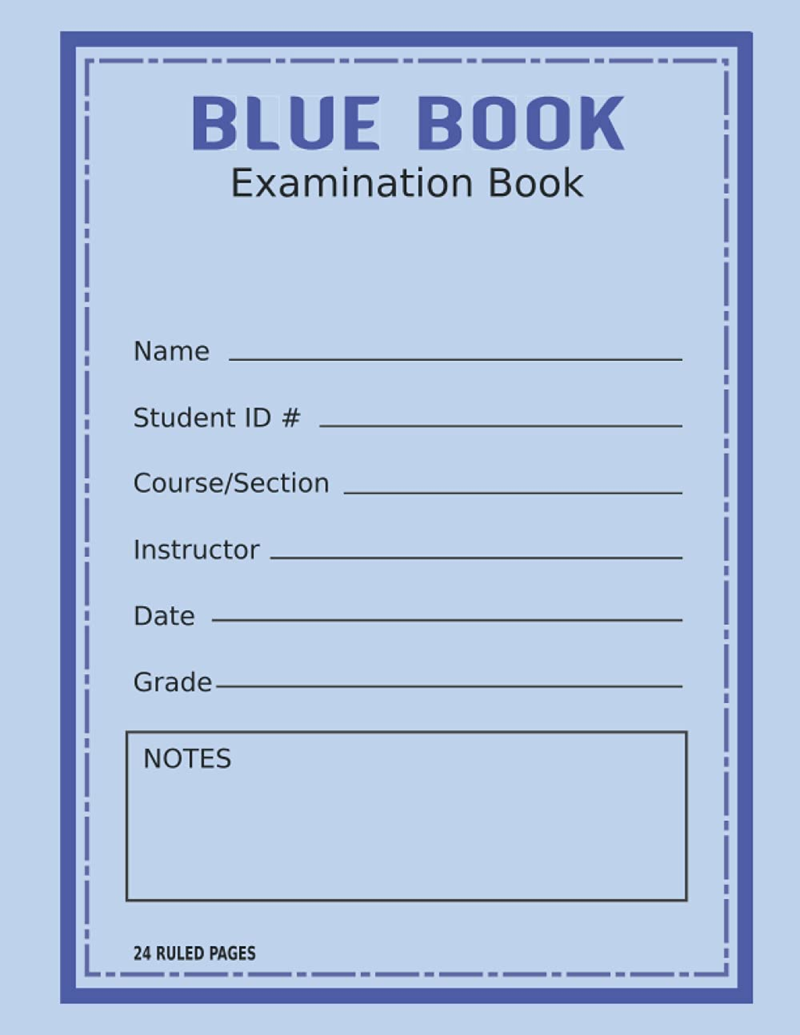What Is a Blue Book Exam?
Students take handwritten exams on blue-covered examination booklets; hence the name Blue Book Examinations. This assessment method prevailed in universities and colleges, especially in the United States. This type of examination is usually performed in courses relating to the Humanities and Social Sciences with a strong concentration on the ability to think critically, to formulate arguments, and to display an in-depth grasp of the complex issues at hand. If you’re in college or ever heading there soon, your professor would most probably say, “Bring a Blue Book for the exam!” But what is a Blue Book exam, and how exactly do you pass it? This short guide will provide you with all the information you need concerning Blue Books in the college, the relevance of the Blue Books, and help you ace the preparation like a professional.
What Are Blue Books in College and Why Are They Used?
Blue Books are little paper booklets with a blue cover. It is filled with lined pages for students to write their answers to essay-type questions during exams. Blue Books are often used in colleges and universities in subjects such as history, literature, philosophy, or social sciences.
Instead of opting for any letter A, B, or C in multiple-choice tests, students must give full-fledged answers. They are Blue Book exams where professors could see how well you know the topic and how clearly you explain it, and could build arguments. Not mere facts, but rather how you think and write.
Why Blue Book Exams Matter in College
This test not only evaluates your memory. It tells your professor that you
- Apprehend
- Use their own words
- Express their thoughts clearly and coherently
- Support those thoughts with good reasons
In a nutshell, these exams are a test of critical thinking and how well you can express your thoughts on paper. The ability to do that will be useful, not only to you in school but throughout your life.
How to Get Ready for a Blue Book Exam in College
- Know the Material Inside Out
The first step toward success is memory when it comes to notes, books, or lectures. Create study guides with key ideas and significant facts. Explain with words you use. It makes you understand and memorize things better.
Try also flashcards, summaries, or mind maps. These become tools of speedy learning while simplifying the whole process.
- Practice Writing Short Essays
Blue Book exams require you to write fast and clearly. This skill takes lots of practice. So, have a friend set a timer and write mock essays in 30-45 minute intervals. Choose topics from your syllabus or old test questions.
Plan your answer before writing and checking your work. Over time, you will get better at writing strong essays quickly with fewer mistakes.
- Think About Possible Questions
Generally, your professor would not inform you about the exact question before the examination. Nonetheless, it is possible to predict content on perhaps the kinds of topics that have been very prevalent in class discussions and might turn up for examination.
Once you have worked out some questions, you can begin trying to write the actual answers. This should, prima facie, assure comfort and confidence on the examination day.
Parts of a Great Blue Book Exam Answer
Start with a Clear Introduction
Start with a few lines about the main argument, generally termed a thesis. It states what subject matter the reader will find in your writing. Then list the main ideas you will explain in the various paragraphs.
Write Strong Body Paragraphs
List the examples or reasons that support your point after stating the topic. Stay concentrated and deal only with one idea per paragraph. Connect ideas with words such as “also,” “for example,” and “because.”
End with a Thoughtful Conclusion
Finish your essay with a little passage that reiterates your thesis in different words. Do not repeat your introduction word-for-word. Try to leave some thought or something new to ponder for your reader.
How to Use Your Time During a Blue Book Exam
Time is short in a Blue Book exam. Here’s a simple plan:
- First 5–10 minutes: Read the question carefully and plan your answer.
- Next 30–40 minutes: Write your essay.
- Last 5–10 minutes: Check your work for mistakes.
If there’s more than one question, split your time evenly. Always leave a few minutes to review your writing.
Top Mistakes to Avoid in a Blue Book Exam
- Going Off Topic
Simply keep to the question. Don’t append anything that doesn’t benefit its answer. Better write less and stay focused on your argument.
- Lack of Organization
An essay full of clutter would be hard to follow. Always plan before writing. Have clear paragraphs and keep the reader guided with a good conjugation-words transition such as “next”, “on the other hand”, or “therefore.”
- Weak Thesis
Your thesis should always be an emphatic statement. Avoid the phrase “I think…”. Instead, simply say what you think along with evidence in its support.
- Untidy Handwriting
If the professor cannot read what you have written, it may cost you some points. So, write neatly; it helps to double-space and leave margins.
- Not Using Time to Review
In the end, try to fix spellings, grammar, and awkward sentences if you have time. These little corrections can mean a lot for your final score.
Simple Tools That Can Help You Prepare
A few handy tools that streamline studying for college-level Blue Book exams:
- Flashcards: Test yourself on terms or dates.
- Study groups: Teach each other and provide hints.
- Mind maps: Draw the ideas and how they correlate.
- Practicals: Write short essays on questions from old tests.
- Notes: Go through them quite often, not just before the exam.

Tips for Clear, Strong Writing in a Blue Book Exam
- The assistant suggests breaking down ideas into simple sentences, not too long or varied, but coherent and moving.
- Avoid the use of long-range planning for writing about perfectionism and other writings about students older than the years.
- Avoid using convoluted examples or facts in support of a post-To italicize personal hyphenated post.
- Avoid using those long, expensive words. Simply avoid the verbosity.
In the beginning, many of your sentences stick more or less with a transition word-First, next, again, surely, and also, then, else, while finally. These kinds of words point up the flow.
Why Professors Still Use Blue Books in College
In today’s era of computers and online tests, the use of Blue Book tests is still rampant. Why? Because they measure your ability to do the following:
- Think independently
- Write precisely
- Construct arguments
- Grasp complex ideas
These are all skills useful in school, work, and life in general.
Conclusion
Blue Book exams in college at first appear to be a bit daunting; however, if the proper steps are taken to prepare, one usually does well. Study the material, practice writing it out, and time yourself. Keep writing clearly with strong ideas.











